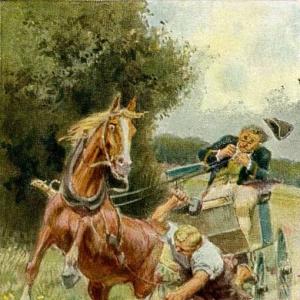Reading time: 9 min
Seven Swabians were once together. The first was Master Schulz. The second, Jackli. The third, Marli. The fourth, Jergli. The fifth, Michal. The sixth, Hans. The seventh, Veitli: all seven had made up their minds to travel about the world to seek adventures, and perform great deeds. But in order that they might go in security and with arms in their hands, they thought it would be advisable that they should have one solitary, but very strong, and very long spear made for them.
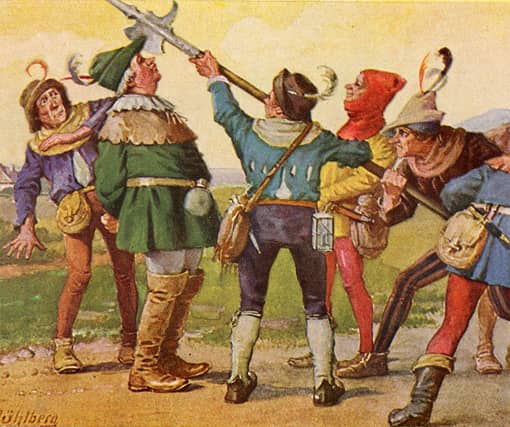 Image: Georg Mühlberg (1863-1925)
Image: Georg Mühlberg (1863-1925)This spear all seven of them took in their hands at once. In front walked the boldest and bravest, and that was Master Schulz; all the others followed in a row, and Veitli was the last. Then it came to pass one day in the hay-making month (July), when they had walked a long distance, and still had a long way to go before they reached the village where they were to pass the night, that as they were in a meadow in the twilight a great beetle or hornet flew by them from behind a bush, and hummed in a menacing manner. Master Schulz was so terrified that he all but dropped the spear, and a cold perspiration broke out over his whole body.
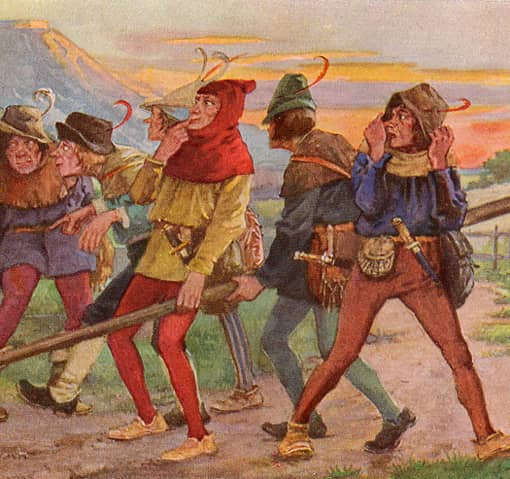 Image: Georg Mühlberg (1863-1925)
Image: Georg Mühlberg (1863-1925)„Hark! hark!“ cried he to his comrades, „Good heavens! I hear a drum.“ Jackli, who was behind him holding the spear, and who perceived some kind of a smell, said, „Something is most certainly going on, for I taste powder and matches.“
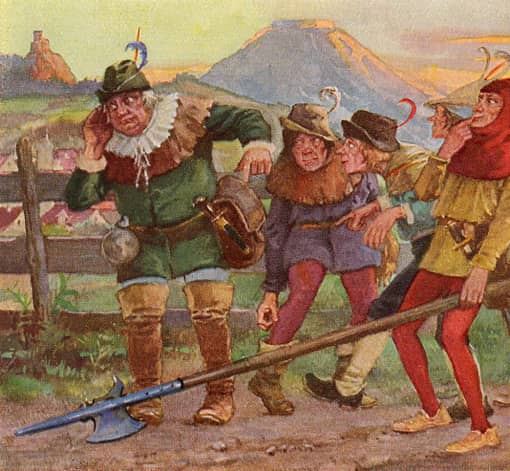 Image: Georg Mühlberg (1863-1925)
Image: Georg Mühlberg (1863-1925)At these words Master Schulz began to take to flight, and in a trice jumped over a hedge, but as he just happened to jump on to the teeth of a rake which had been left lying there after the hay-making, the handle of it struck against his face and gave him a tremendous blow. „Oh dear! Oh dear!“ screamed Master Schulz. „Take me prisoner. I surrender! I surrender!“
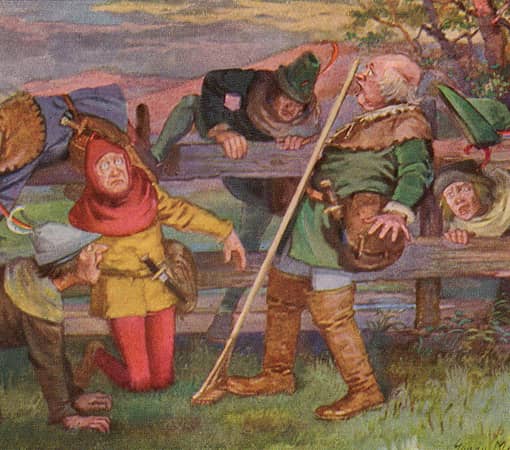 Image: Georg Mühlberg (1863-1925)
Image: Georg Mühlberg (1863-1925)The other six all leapt over, one on the top of the other, crying, „If you surrender, I surrender too! If you surrender, I surrender too!“ At length, as no enemy was there to bind and take them away, they saw that they had been mistaken, and in order that the story might not be known, and they be treated as fools and ridiculed, they all swore to each other to hold their peace about it until one of them accidentally spoke of it. Then they journeyed onwards. The second danger which they survived cannot be compared with the first. Some days afterwards, their path led them through a fallow-field where a hare was sitting sleeping in the sun. Her ears were standing straight up, and her great glassy eyes were wide open. All of them were alarmed at the sight of the horrible wild beast, and they consulted together as to what it would be the least dangerous to do.
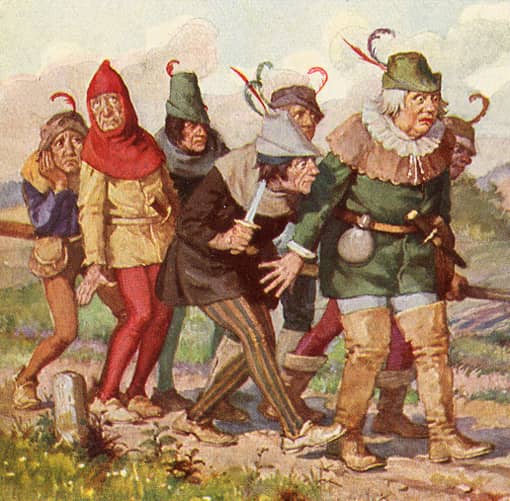 Image: Georg Mühlberg (1863-1925)
Image: Georg Mühlberg (1863-1925)For if they were to run away, they knew that the monster would pursue and swallow them whole. So they said, „We must go through a great and dangerous struggle. Boldly ventured, is half won,“ and all seven grasped the spear, Master Schulz in front, and Veitli behind. Master Schulz was always trying to keep the spear back, but Veitli had become quite brave while behind, and wanted to dash forward and cried,
„Strike home, in every Swabian’s name,
Or else I wish ye may be lame.“
But Hans knew how to meet this, and said,
„Thunder and lightning, it’s fine to prate,
But for dragon-hunting thou’rt aye too late.“
Michal cried,
„Nothing is wanting, not even a hair,
Be sure the Devil himself is there.“
Then it was Jergli’s turn to speak,
„If it be not, it’s at least his mother,
Or else it’s the Devil’s own step-brother.“
And now Marli had a bright thought, and said to Veitli,
„Advance, Veitli, advance, advance,
And I behind will hold the lance.“
Veitli, however, did not attend to that, and Jackli said,
„Tis Schulz’s place the first to be,
No one deserves that honor but he.“
Then Master Schulz plucked up his courage, and said, gravely,
„Then let us boldly advance to the fight,
And thus we shall show our valour and might.“
Hereupon they all together set on the dragon. Master Schulz crossed himself and prayed for God’s assistance, but as all this was of no avail, and he was getting nearer and nearer to the enemy, he screamed „Oho! oho! ho! ho! ho!“ in the greatest anguish. This awakened the hare, which in great alarm darted swiftly away. When Master Schulz saw her thus flying from the field of battle, he cried in his joy.
„Quick, Veitli, quick, look there, look there,
The monster’s nothing but a hare!“
But the Swabian allies went in search of further adventures, and came to the Moselle, a mossy, quiet, deep river, over which there are few bridges, and which in many places people have to cross in boats. As the seven Swabians did not know this, they called to a man who was working on the opposite side of the river, to know how people contrived to get across. The distance and their way of speaking made the man unable to understand what they wanted, and he said „What?
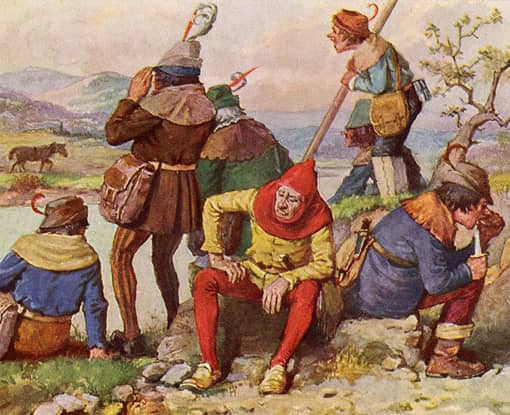 Image: Georg Mühlberg (1863-1925)
Image: Georg Mühlberg (1863-1925)what?“ in the way people speak in the neighborhood of Treves. Master Schulz thought he was saying, „Wade, wade through the water,“ and as he was the first, began to set out and went into the moselle. It was not long before he sank in the mud and the deep waves which drove against him, but his hat was blown on the opposite shore by the wind, and a frog sat down beside it, and croaked „Wat, wat, wat.“
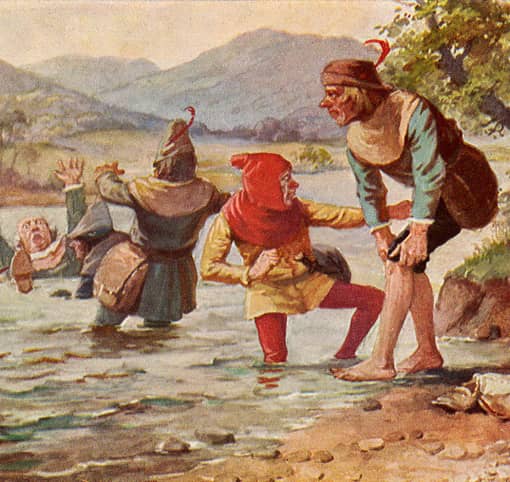 Image: Georg Mühlberg (1863-1925)
Image: Georg Mühlberg (1863-1925)The other six on the opposite side heard that, and said, „Oho, comrades, Master Schulz is calling us. If he can wade across, why cannot we?“ So they all jumped into the water together in a great hurry, and were drowned, and thus one frog took the lives of all six of them, and not one of the Swabian allies ever reached home again.
 Learn languages. Double-tap on a word.Learn languages in context with Childstories.org and Deepl.com.
Learn languages. Double-tap on a word.Learn languages in context with Childstories.org and Deepl.com.Backgrounds
Interpretations
Adaptions
Summary
Linguistics
„The Seven Swabians“ is a German fairy tale collected by the Brothers Grimm, Jacob and Wilhelm, in their famous collection „Grimms‘ Fairy Tales“ (originally titled „Children’s and Household Tales“ or „Kinder- und Hausmärchen“ in German). The Brothers Grimm were German academics, philologists, and cultural researchers who compiled and published over 200 folktales in the early 19th century.
The Swabians in the title refer to a group of people from Swabia, a historical region in present-day southwest Germany that includes parts of the modern states of Baden-Württemberg and Bavaria. Swabian culture, language, and customs have distinct features, and the term „Swabian“ often carries a stereotype of a simple, frugal, and unsophisticated person.
The fairy tale, like many of the stories collected by the Brothers Grimm, has roots in oral tradition and folklore. It was first published in 1815 in the second volume of their collection. The story serves as a humorous and cautionary tale, using the adventures of the seven Swabians to convey various messages and morals, as outlined in the interpretations above.
It is important to note that the Brothers Grimm did not create the stories in their collection; rather, they gathered them from various sources, including friends, acquaintances, and written texts. As the stories were passed down through generations, they evolved and changed, reflecting the values and beliefs of the time. The Brothers Grimm played a significant role in preserving these traditional stories for future generations and popularizing them worldwide.
„The Seven Swabians“ is a cautionary tale that can be interpreted in various ways. Some possible interpretations include.
Overconfidence and foolishness: The Swabians‘ misadventures demonstrate the dangers of overconfidence and foolishness. They repeatedly misinterpret their surroundings and jump to conclusions, leading them to make grave mistakes. The story serves as a reminder that it is essential to assess situations carefully and think critically before taking action.
The importance of communication: The Swabians‘ downfall at the Moselle River highlights the importance of clear communication. Misunderstanding the local man’s response, they make a fatal decision. The story emphasizes the need for effective communication to avoid misunderstandings and their potentially disastrous consequences.
The dangers of groupthink: Throughout the story, the Swabians follow each other’s actions without questioning their validity. This conformity leads to a series of poor decisions and ultimately their demise. The tale can be seen as a warning against blindly following the crowd and the importance of independent thinking.
Fear and its consequences: Fear is a recurring theme in the story, as the Swabians are easily frightened by harmless creatures and situations. Their fear leads them to overreact and make irrational decisions. The tale illustrates the power of fear and the importance of facing it with courage and rationality.
Satire on chivalry and heroism: The story can be read as a satirical take on the chivalric tales popular during the time. The Swabians, attempting to perform great deeds and seek adventures, end up bumbling their way through their journey. The tale mocks the romanticized notion of heroism by depicting the protagonists as naive and foolish.
„The Seven Swabians“ has been adapted and retold in various forms over the years, including:
Children’s books: The tale has been adapted into numerous children’s books, such as „The Seven Swabians“ by Jacob and Wilhelm Grimm, illustrated by Bernadette Watts.
Theater: The story has been adapted for the stage, with various theatrical productions and adaptations performed in different parts of the world.
Films: The tale has been adapted into several films, including the 1937 German film „Die sieben Schwaben“ directed by Erich Engel.
Television: The story has been adapted for television in various formats, such as animated series and live-action productions.
Comics: The tale has also been adapted into comic books and graphic novels, including „The Seven Swabians“ by J. Otto Seibold.
Video games: The story has been adapted into a video game called „The Seven Swabians“ by German game developer Daedalic Entertainment.
Each adaptation of the tale presents a unique interpretation and creative retelling of the original story, highlighting different themes and emphasizing different aspects of the characters and plot.
„The Seven Swabians“ is a fairy tale by the Brothers Grimm that tells the story of seven Swabian men who set out on a journey to seek adventures and perform great deeds. The seven Swabians are Master Schulz, Jackli, Marli, Jergli, Michal, Hans, and Veitli. They decide to travel with a single long spear for protection, which all of them hold at once.
While walking through a meadow one day, they hear a beetle or hornet humming menacingly. Fearing it is a drum signaling an enemy attack, they flee, only to realize they were mistaken. To avoid ridicule, they vow to keep the incident a secret. Soon after, they encounter a sleeping hare in a field, which they mistake for a fearsome monster. They work up the courage to attack the „monster,“ but the hare simply wakes up and runs away.
The Swabians continue their journey and arrive at the Moselle River, where they see a man working on the opposite bank. They ask how to cross the river, but the man doesn’t understand them and replies with „What? What?“ Master Schulz, misunderstanding the response as „Wade, wade through the water,“ attempts to cross the river on foot, but drowns. The others hear a frog croaking nearby and, thinking it’s Master Schulz calling for them, also try to cross the river and subsequently drown. In the end, the seven Swabians perish, and none of them ever return home.
The fairy tale „The Seven Swabians“ by the Brothers Grimm is a humorous and satirical tale that can be analyzed from multiple linguistic angles, including its structure, characterization, and use of various literary devices.
Structure and Narrative
Chronological Structuring: The tale follows a straightforward chronological order, beginning with the introduction of the Seven Swabians and their decision to seek out adventure, followed by a series of escalating encounters that lead to the story’s climax.
Episodes: The storyline is episodic, detailing separate misadventures of the Swabians as they encounter imagined threats.
Each episode presents a similar pattern: an overreaction to a misunderstanding, followed by comedic consequences.
Characterization
Collective Characterization: Rather than focusing on individual character development, the tale treats the Seven Swabians collectively, often emphasizing their collective folly and cowardice.
Caricature of National Traits: The Swabians are depicted according to regional stereotypes of the time, characterized by a lack of discernment and bravery, thus reflecting societal views and prejudices.
Language and Dialogue
Simple Language: The language in the tale is basic and direct, aligned with its didactic and humorous intent. The simplicity ensures that the narrative and its lessons are easily understood.
Exaggeration: Dialogue often features exaggerated expressions of fear and bravado, contributing to the comedic effect. For example, the Swabians attribute menacing qualities to harmless creatures like a beetle and a hare.
Rhyme and Rhythm: The incorporation of rhyming couplets during moments of tension adds a playful and rhythmic quality to the narrative, as seen in the exchanges among the Swabians.
Literary Devices
Humor and Satire: The tale uses humor largely through the exaggerated reactions and misinterpretations of the Swabians, satirizing their cowardice and simplicity.
Irony: Dramatic irony is present in the audience’s awareness of the Swabians‘ mistaken perceptions; for example, perceiving a hare as a dragon or misunderstanding a frog’s croak as a call from their leader.
Symbolism: The spear symbolizes misplaced confidence and collective overreliance, showing how unity without wisdom can lead to folly.
Themes
Fear and Misinterpretation: A central theme is how fear can distort perceptions and lead to irrational decisions. This is evident in the Swabians‘ repeated misinterpretation of benign situations as threatening.
Collective Folly: The story emphasizes the dangers of collective folly, where the group’s actions, driven by ignorance and a lack of critical thinking, lead to disastrous consequences.
Cultural and Historical Context
Regional Stereotypes: The tale plays upon contemporary regional stereotypes of the Swabians as foolish and simple, reflecting historical perceptions in a light-hearted manner.
Moral Teaching: As with many Grimm fairy tales, there is a moral dimension, cautioning against the perils of ignorance and encouraging discernment in the face of uncertainty.
Overall, „The Seven Swabians“ is a linguistic and thematic exploration of collective ignorance and the comedic potential of miscommunication, packaged as a light-hearted parable.
Information for scientific analysis
Fairy tale statistics | Value |
|---|---|
| Number | KHM 119 |
| Translations | DE, EN, ES, FR, PT, HU, IT, JA, NL, PL, RU, TR, VI, ZH |
| Readability Index by Björnsson | 26.7 |
| Flesch-Reading-Ease Index | 82.7 |
| Flesch–Kincaid Grade-Level | 5.4 |
| Gunning Fog Index | 7.5 |
| Coleman–Liau Index | 8.6 |
| SMOG Index | 8 |
| Automated Readability Index | 5.5 |
| Character Count | 5.567 |
| Letter Count | 4.259 |
| Sentence Count | 70 |
| Word Count | 1.026 |
| Average Words per Sentence | 14,66 |
| Words with more than 6 letters | 124 |
| Percentage of long words | 12.1% |
| Number of Syllables | 1.325 |
| Average Syllables per Word | 1,29 |
| Words with three Syllables | 49 |
| Percentage Words with three Syllables | 4.8% |

 Facebook
Facebook  Whatsapp
Whatsapp  Messenger
Messenger  Telegram
Telegram Reddit
Reddit
